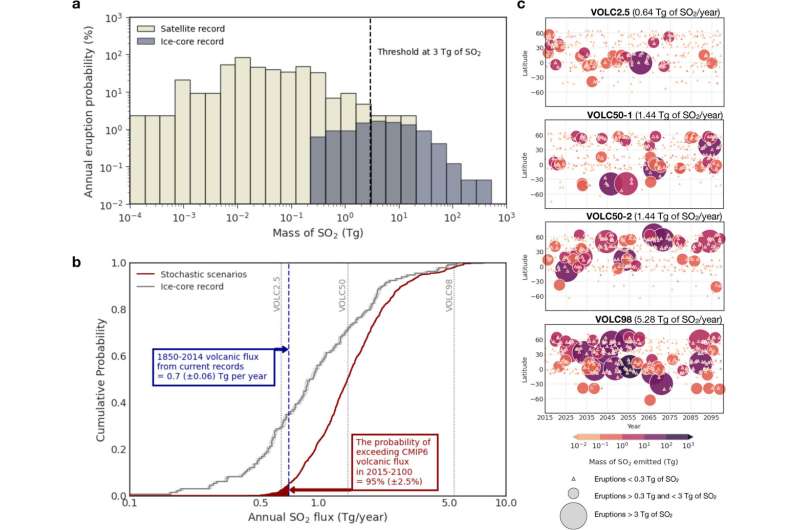Effect of volcanic eruptions significantly underestimated in climate projections, study shows

Researchers have found that the cooling effect that volcanic eruptions have on Earth’s surface temperature is likely underestimated by a factor of two, and potentially as much as a factor of four, in standard climate projections.
While this effect is far from enough to offset the effects of global temperature rise caused by human activity, the researchers, led by the University of Cambridge, say that small-magnitude eruptions are responsible for as much as half of all the sulfur gases emitted into the upper atmosphere by volcanoes.
The results, reported in the journal Geophysical Research Letters, suggest that improving the representation of volcanic eruptions of all magnitudes will in turn make climate projections more robust.
Where and when a volcano erupts is not something that humans can control, but volcanoes do play an important role in the global climate system. When volcanoes erupt, they can spew sulfur gases into the upper atmosphere, which forms tiny particles called aerosols that reflect sunlight back into space. For very large eruptions, such as Mount Pinatubo in 1991, the volume of volcanic aerosols is so large that it single-handedly causes global temperatures to drop.
However, these large eruptions only happen a handful of times per century—most small-magnitude eruptions happen every year or two.
“Compared with the greenhouse gases emitted by human activity, the effect that volcanoes have on the global climate is relatively minor, but it’s important that we include them in climate models, in order to accurately assess temperature changes in future,” said first author May Chim, a Ph.D. candidate in the Yusuf Hamied Department of Chemistry.
Standard climate projections, such as the Intergovernmental Panel on Climate Change (IPCC) Sixth Assessment Report, assume that explosive volcanic activity over 2015–2100 will be at the same level as the 1850–2014 period, and overlook the effects of small-magnitude eruptions.
“These projections mostly rely on ice cores to estimate how volcanoes might affect the climate, but smaller eruptions are too small to be detected in ice-core records,” said Chim. “We wanted to make a better use of satellite data to fill the gap and account for eruptions of all magnitudes.”
Using the latest ice-core and satellite records, Chim and her colleagues from the University of Exeter, the German Aerospace Center (DLR), the Ludwig-Maximilians University of Munich, Durham University, and the UK Met Office, generated 1,000 different scenarios of future volcanic activity. They selected scenarios representing lower, median and high levels of volcanic activity, and then performed climate simulations using the UK Earth System Model.
Their simulations show that the impacts of volcanic eruptions on climate, including global surface temperature, sea level and sea ice extent, are underestimated because current climate projections largely underestimate the plausible future level of volcanic activity.
For the median future scenario, they found that the effect of volcanoes on the atmosphere, known as volcanic forcing, is being underestimated in climate projections by as much as 50%, due in large part to the effect of small-magnitude eruptions.
“We found that not only is volcanic forcing being underestimated, but small-magnitude eruptions are actually responsible for as much as half of all volcanic forcing,” said Chim. “These small-magnitude eruptions may not have a measurable effect individually, but collectively, their effect is significant.
“I was surprised to see just how important these small-magnitude eruptions are—we knew they had an effect, but we didn’t know it was so large.”
Although the cooling effect of volcanoes is being underestimated in climate projections, the researchers stress that it does not compare with human-generated carbon emissions.
“Volcanic aerosols in the upper atmosphere typically stay in the atmosphere for a year or two, whereas carbon dioxide stays in the atmosphere for much, much longer,” said Chim. “Even if we had a period of extraordinarily high volcanic activity, our simulations show that it wouldn’t be enough to stop global warming. It’s like a passing cloud on a hot, sunny day: the cooling effect is only temporary.”
The researchers say that fully accounting for the effect of volcanoes can help make climate projections more robust. They are now using their simulations to investigate whether future volcanic activity could threaten the recovery of the Antarctic ozone hole, and in turn, maintain relatively high levels of harmful ultraviolet radiation at the Earth’s surface.
More information:
Man Mei Chim et al, Climate Projections Very Likely Underestimate Future Volcanic Forcing and Its Climatic Effects, Geophysical Research Letters (2023). DOI: 10.1029/2023GL103743
Citation:
Effect of volcanic eruptions significantly underestimated in climate projections, study shows (2023, June 23)
retrieved 23 June 2023
from https://phys.org/news/2023-06-effect-volcanic-eruptions-significantly-underestimated.html
This document is subject to copyright. Apart from any fair dealing for the purpose of private study or research, no
part may be reproduced without the written permission. The content is provided for information purposes only.
For all the latest Science News Click Here
For the latest news and updates, follow us on Google News.

